- This trip is ideal who do
not want to do long drives. Places covered Indore, Dhar, Mandu, Maheshwar,
Burhanpur, Omkareshwar and back to Indore. Article has day wise places visited
and what to see in each place with album links. Pic captions are quite
detailed.
Day-wise Program - Day 1: Indore. Day 2: Indore–Dhar–Mandu. Day 3: Mandu–Maheshwar. Day
4: Maheshwar–Burhanpur. Day 5: Burhanpur–Omkareshwar. Day 6: Omkareshwar–Indore.
In hindsight should have kept an extra day at Omkareshwar. It was just too
tight.
Distances: Indore to Dhar 64 kms to Mandu 38 kms to Maheshwar 39 kms to Burhanpur
170 kms to Asirgarh Fort 22 kms to Omkareshwar 102 kms to Indore 78kms.
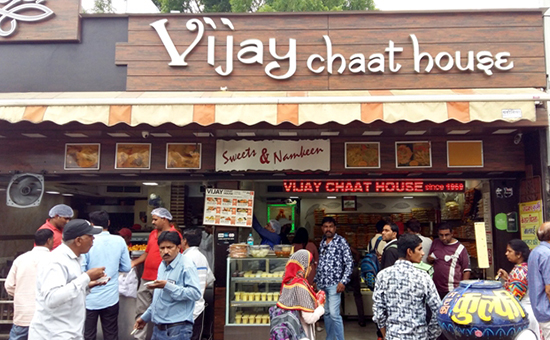 Vijay Chaat House Chappan Dukan Indore
Vijay Chaat House Chappan Dukan Indore
DAY 1 INDORE
Reached Indore at 8.45 am. Checked into a hotel, had pohe and masala chai for breakfast. Took an auto to RAJWADA, the Holkar Palace. The capital of the Holkars was Maheshwar. Malhar Rao Holkar shifted his capital to Indore 1818. It housed the Durbar Hall, Secretariat, Treasury & King’s office. First floor is a must see museum that tells you about the history of the Holkars, displays palanquins, utensils etc. On ground floor is a Shivalaya called Martand Mandir.
About ten minutes from Rajwada, through market, is Kanch Mandir. Can
skip. Krishnabai Holkar ki chattri is close by.
It has elements of Rajput, Maratha & Mughal architecture. At some
distance visit the highly revered Ganesh Mandir.
Next stop was Lalbaugh Palace. The government took it over in 1988 & made a Nehru Centre. Even though it is badly maintained is worth a visit, not as grand as Rajasthan palaces.
Was hungry so went to ‘Chappan Dukaan’. Visit Vijay Chaat House for Kachoris, Samosa, Khopra (coconut patties), Skanjvi (milk based drink), Kulfi & lots more. Slightly ahead is a shop that sells Hot Dogs. All awesome. Also visit Goyal Juice in Palasia market and Hotel Rajhans Malwa style thali.
Post dinner visited SARAFA the night street food market. Loved it. Must visit Joshi Dahiwade Wale, Annapurna Paan Shop, Sanwariya’s cart selling sabudana khichdi + bana ke + gathiya chaat and Kamal Coconut Crush.
Keep a day for Indore.
Pictures
of Rajwada Indore
Pictures
of Sarafa and Chappan Dukan
Indore is
a great place for street food
Day 2 Dhar
Left for Dhar at 6.30 to reach by about 8.30. Headed for Bhojshala Mandir. It was Friday so access for Hindus is closed. So also on Tuesday Muslims cannot visit the Dargah.
“In 920 A.D. King Vairisiṃha transferred his headquarters from Ujjain to Dhar, which became the seat of the Parmar chiefs of Malwa. Dhar Fort, located on a hillock, is reachable by a rock-paved road that ends at an old prison housing a small Archaeological Museum. To the left, a path leads to the 16th-century palace Kharbooja Mahal with melon-shaped domes offering spectacular views over town.” Reference 2
Art Gallery inside fort is good. Royal Cenotaphs (chhatris) close by,
can skip. Dhar was ruled by the Marathas so you see statues of Maratha rulers.
Pictures of Art
Gallery Dhar and Fort
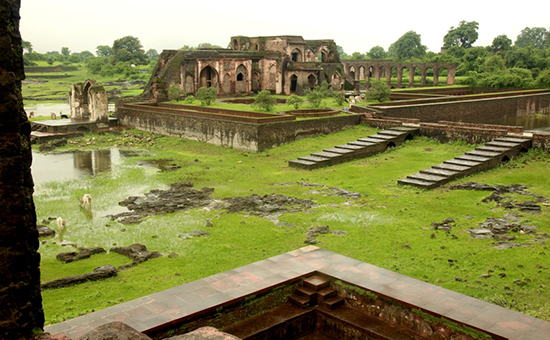 Water body in Royal Enclave Mandu
Water body in Royal Enclave Mandu
Day 2 and 3 till lunch in Mandu
It was raining for most of the Dhar Mandu drive awesome. There
are four gates. Mandu is at a height of 2000 feet, is separated from the main
Malawa Plateau by a deep ravine Kakra Khoh. Reached by 12.30, stayed at the MP
Tourism Resort. They have a list of guides to choose from.
In a nutshell here is what you should see. Jahaz Mahal, Palace
complex, Jama Masjid, Ram Mandir and Lohani Caves at one go. Do see ruins of
Hindu temples stored in Jama Masjid and Art Gallery close by. Baz Bahadur
Palace, Rewa Kund and Roopmati Pavilion at other end of Mandu. In between is
Darya Khan’s Tomb.
Mandu is full of water bodies & step-wells. They are full
in the monsoons and a sheer delight. It was very foggy at times could barely
see.
Pictures
of Mandu in the rains
Pictures
of MANDU
Pictures
of Art Gallery Mandu
Travel blogger Rangan Dutta has divided sight-seeing into four
parts. We present excerpts.
1 Royal Enclave is the heart of Mandu. Keep adequate time – worth it. “Jahaz Mahal is icon of Mandu. The elongated building is 360 feet in length & only 50 feet in breadth stands on a narrow stretch of land sandwiched between the two water bodies of Kapur and Munj Talao. The Jahaz Mahal towers above the two water bodies and in monsoon the water reaches right up to the edge of the monument giving it a ship like appearance, hence the name Jahaz Mahal.
Hindola Mahal or the swing palace is located north of the Jahaz Mahal. The T-shaped building with its sloping buttressed wall was constructed during the latter part of the reign of Ghiyathuddin Khalji (1469 – 1500).
Taveli Mahal is a simple looking, three storied, building on the right of the entrance of the Royal Enclave once served as a royal stable. See the ASI museum worth it.
Lohani Caves is enroute to Royal Enclave. It is evidence of Mandu’s Hindu past. See iron pillar. You get a great view from here.
Gadaa Shah’s
House & Shop. Historians doubt the
identity of Gada Shah, but the ruins of his shop and house are a must
visit in Mandu. It is opposite the MPTDC Retreat, is a two storied structure ie
approached by a gigantic pointed arch gateway.”
Ram Mandir. In 1823 Pandit Raghunandji Das from Pune came to Mandu. Through his powers he saw certain murthis, told the queen of Dhar Meerabai S Pawar. She did not believe but said go ahead. During excavation they found 6 murthis i.e. Chauturbhuj Ram (four handed-dated 901 A.D.), Sita Maiya, Lakshman, Hanumanji, Suryanarayan & 16th Jain Tirthankara Shantinath.
2 Central Group has Jami Masjid, Ashrahi Mahal, Hoshang Shah’s tomb and Ram Mandir. Close by is a Jain mandir. See intricate Jali work in Hoshang Shah’s tomb and ruins of Hindu temples that are kept in a separate room.
3 Darya Khan’s Tomb - Hathi Mahal or Hathi Page Mahal, literally meaning Elephant Leg Palace, the monument gets its name from the massive elephantine pillars at the four corners of the monument.” Somewhere close by is ECHO Point.
4 Rewa
Kund Group “At northern end of Rewa Kund was a water-lift to supply water to Baz Bahadur Palace. On the banks of the Rewa Kund and at the foot of a hill lies the Baz Bahadur’s Palace. It was originally built in 1509. The palace is approached by a flight of stairs and the main part consists of an open courtyard with a floral shaped fountain in the middle. To the north of the palace, beyond the colonnade, projects an octagonal pavilion with arches. The spacious terrace is crowned with two chatris or pavilions and offers a grand view extending all the way to Roopmati’s Pavilion.”
Roopmati Pavilion. Around 1554 Malik Bayazaid became ruler with title of Baz Bahadur. After disgraceful defeat by Rani Durgawati he almost forswore fighting. He gave himself to music in which the beautiful Rupamati proved to be his favourite consort. This building, constructed on the edge of a precipice overlooks Nimar valley. It was perhaps originally a watchtower later on Rupmati viewed the Narmada from here. Part of the pavilion has a water storage facility.
It has two chatris that provide a grand view of the Nimar
plains. It is said that on a clear day the view can extend all the way up to
the Narmada in the south. It is an excellent sun set point.
Roopmative is a place where you should spend more time very
nice.
Enroute from Mandu to Maheshwar is Nilkanth Mahadev. It was originally a Shiva temple converted into a palace by Akbar. Today it is in active worship as a temple.
Mandu needs a day, two if you want to explore in depth.
Reached Maheshwar by 5.30 pm. Checked into the awesome Madhya
Pradesh Tourism hotel. Walked by the ghats on the river Narmada and went
boating. What I missed doing is a boat ride to Baneshar mid-river and seeing
the sun-set from there.
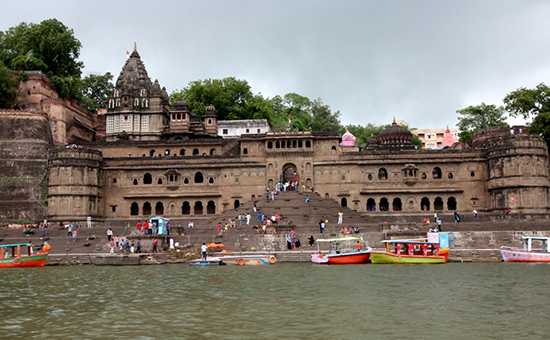 Ahilyabai Fort and Cenotaph Complex Maheshwar.
Ahilyabai Fort and Cenotaph Complex Maheshwar.
Day 3 and 4 Maheshwar,
reached Burhanpur 8 pm
Went for a morning walk on river banks starting 6.30 am. Saw
ladies drying their saris and pandits doing puja. Very peaceful. My second
visit, just love the place.
On the river banks are the Tilkeshwar Mahadev, Kashi Vishwanath and Narmada Mata mandirs and the chhatri (Samadhi) of Ahilyabai Holkar. Also on river bank and inside Ahilyabai Fort is the immensely ornate and must see Cenotaph Complex Climb the steps and you will enter Ahilyabai Holkar Palace. It houses the Rajwada, royal court and residence.
Just walk around Maheshwar. Something very special about it.
You need to experience it.
Do see the Lingarchan Puja in the fort. This puja was started in 1766 by Ahilyabai Holkar and takes places every morning from 8.30 to 9.30 am. This puja was meant to bless the residents of Maheshwar. That time its population was 1.10 lakhs. Everyday 111 Brahmins would prepare a board with 1,000 little shivlings made out of the soil of the fields, each ball representing one person. These boards would be blessed and the lingams collected and finally offered in the river Narmada. This tradition continues 250 years later, the difference being that 11 Brahmins make the shivlings today, each one makes 1100 lingams.
Maheshwar is well known for Maheshwari Saris. Do visit Rehwa Society ie run by the Holkar Trust – genuine stuff. Another very reliable shop is Hansa Creations ie before you drive up to fort entrance. I also bought salwar suit from the Weavers Co-operative i.e. at the Madhya Pradesh Tourism resort. Today, besides saris, Maheshwari weaves are used to create kurtas, shirts, stoles, vests, jackets, dupattas and even furnishings.
“The
uniqueness of Maheshwari saris lies in the weave. The body of the sari has
small checks, stripes, or can be plain, but the typically striped pallu and
border designs are inspired by traditional motifs, or architectural
embellishments found in the town’s temples and monuments.” Reference 2.
Pictures of
MAHESHWAR Mahishmati
Pictures of
Maheshwar Saris Maheshwar
Pictures of
Ahilyabai Holkar Fort Maheshwar
Do
see how saris are made at Rehwa Society ie part of the fort complex. Left
Maheshwar about 4.45 pm and reached Burhanpur by 7.45 pm. Road were good. Stayed
at the Madhya Pradesh Tourism hotel – functional and comfortable.
Keep
a day for Maheshwar, old name Mahishmati.
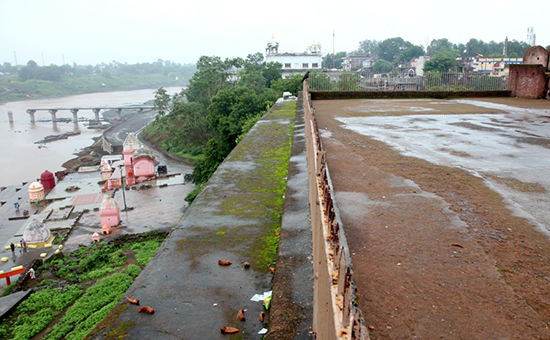 Ghats on Tapti River Burhanpur
Ghats on Tapti River Burhanpur
Day 5 Burhanpur/Asirgarh Fort – reached Omkareshwar
Burhanpur
is known because it is where Shah Jahan’s wife Mumtaz Khal was buried after she
died whilst giving birth to their 14th child. Her remains were then taken
to Agra.
“In the Indian scriptures, Burhanpur is mentioned as Bhrignapur, taking its name from Bhrigu Rishi who not just did his Tapa here but also wrote Bhrigu Samhita here on the banks of Tapti River. I found the name Brahmapuri written at many places but I could not place a temple dedicated to Brahma here or any reference to him.” Reference 3
Visited
the Ghats along the Tapti River that have
many a Shiva temple. On river bank is Badshahi Quila. Lower portion is mostly
in ruins. Top part has Diwan-e-Khas and Zenana Hammam, the baths were decorated
with beautiful frescoes on the ceilings some of which still survive.
Since Guru Nanak visited the town in the 16th century his visit is commemorated by the Gurudwara Sangat Patshali Pahili. The 10th Guru too visited. Unless you are a devout can skip.
We drove past Jama Masjid but missed seeing it. “Its symmetrical arches and sparsely decorated pillars create a sense of severe beauty, while the two 36m high minars tower over the mosque’s arched compound.” Noted travel blogger Anuradha Goyal wrote that “besides the stone carved niches is the inscription in Sanskrit and a long wooden rosary with more than 1000 large sized beads.” Even in Asirgarh fort, 22 kms away, there was a Sanskrit inscription in the mosque. There it is clear that the masjid was made on ruins of a temple because the temple plinth is still visible.
Close by is Dargah-E-Hakimi the most sacred pilgrimage for Dawoodi Bohra community. It is the mazar of Syedi Abdulquadir Hakimuddin who came to Burhanpur in 1729 to spread the word of the Prophet. Very well maintained, very good vibrations, do visit.
Burhanpur
boasts of an elaborate system for transporting water. The underground channels
were used to supply water to the city well into the 20th century. Kundi Bhandara, 8 kms from Burhanpur worth a look.
It is partially closed although my driver was told fully closed.
At some distance from Burhanpur is Ahukhana at Jainabad. It is where Shah Jahan’s wife Mumtaz Mahal was buried. She died in 1631 whilst giving birth to their 14th child princess Gauhara. Quite unimpressive to say the least.
On
the outskirts is the tomb of Shah Nawaz Khan. It is called Black Taj Mahal for its resemblance to the Taj
Mahal. Access road is bad, can skip.
Missed visiting the following. One, three Devi temples i.e. Asha Devi near Asirgarh, Renuka Devi and temple of Icchadevi i.e. 23 kms from Buranpur. Believed to answer any prayer made to her, the Goddess is much revered by the locals. Two, Nathdwara inspired Bahuji Maharaj ka Mandir – its two-inch golden murti of Sri Krishna is so small that devotees can only see it through a telescope. Three, giant elephant stone in the Tapti. Also see Balaji Maharaj ka Mandir.
Burhanpur
is famous for mawa jalebis, chiwda, and lasaniya sev and signature daraba.
ASIRGARH FORTIt
is 22 kms before Burhanpur. Area was lush green, lots of fog and the drive
though steep was enjoyable. Original name of fort was “Asa Ahir Garh.
Later it became Asa Ahir and this became Ashirgarh Fort”. Fort at a height of
about 900 feet.
Asirgarh founds a reference in Mahabharata as Ashwathammagiri. From 9-12th century it was under domination of Tak Rajput. It was under control of Muslims from 1295 A.D. During British rule it became a cantonment. Asirgarh fort was built by Hindus and was ruled by Ahirs, Bargujars, Moughals, Holkars & Britishers. It has seen many phases of history.
There is
no straight entry into the fort – there are turns and the space is narrow – one
reason could be to prevent elephants from break opening the gate. The fort was
built by King Asa Ahir – Ahir is also referred to as Yadav. Ahirs are followers
of Sri Krishna.
The fort is on a plateau. It has a huge open area with numerous water
tanks. Our ancestors paid so much importance to water storage – saw this in
Chittorgarh fort too.
Fort
has a Jama Masjid (built on temple ruins as you can see in album), British
relics that I skipped and a Shiva temple.
Mahadeo Mandir. According to tradition, the son of Guru Dronacharya, Ashwatthamma worships this ancient Shiv temple every day. The watchman leaves by 5 pm ish and returns next morning. He said fresh flowers are found in the sanctum every morning.
Keep
1.5 days for Burhanpur and Asirgarh Fort.
To
see pictures of Asirgarh Fort
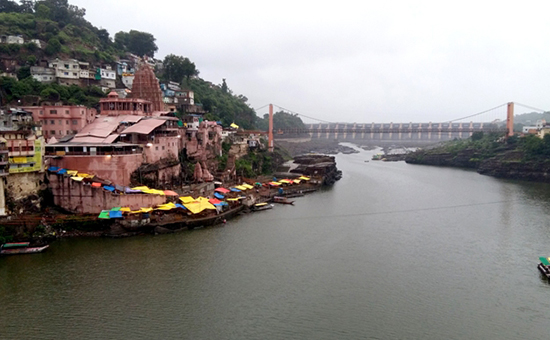 Omkareshwar Jyotirling on the banks of Ma Narmada
Omkareshwar Jyotirling on the banks of Ma Narmada
Day 5 and 6 Omkareshwar Jyotirling
Reached at 5.30 pm, about a 90 minute drive from Asirgarh
Fort. The Madhya Pradesh Tourism resort gives you a very good overview of the
island. Had hot bhajiya, masala chai and left for darshan. Fortunately it was
not crowded. You can use bridge or boat to reach the island.
“The Shivalinga is in the form of a rock on which constantly
water is offered. Three times a day the Abhishek is done with milk, curd, and
Narmada water. Behind the Shivalinga in a niche is the image of Parvati in
silver. Morning Puja is done by temple trust, day puja is done by Scindias and
evening one by the Holkars.” Reference 3
The island on which is the jyotirling is in the shape of OM
hence the name. Front side is river Narmada, rear side of island is river Kaveri.
Where they meet is called Triveni Sangam.
Adi Sankara met his Guru, Sri Govindhapada, in a cave that is just below the Omkareshwar temple. Do visit Govindeshwar Cave.
‘In
recorded history, Omkareshwar was under the Parmar Rulers of Malwa from 10-13thCE,
followed by Chauhan Rajputs. Even during the overall Mughal rule, Omkareshwar
was under the administration of Chauhans. In 18th CE Marathas
took over and that is when a lot of temples were built or renovated. Omkareshwar
Island is a living island. The part of towns on the island is called Shivpuri.
It is said that once upon a time there used to be towns of Brahmpuri and
Vishnupuri. Together they formed the Tripuri.’ Reference 3
Next morning left at 6 am for the panch-kosi parikrama (6 km/2.5-3 hrs), around the Mandhata hill. At the Triveni Sangam devotees are supposed to take a bath. It was raining all along the parikrama so skipped. “The route passes through Khedapati Hanuman Mandir, Omkarnath Ashram, Kedareshwar Temple, Ramakrishna Mission Ashram, Markanda Ashram with 12 meter high image of Sri Krishna, Narmada Kaveri Sangam where Kuber meditated to become king of Yakshas, Rin Mukteshwar Temple, Dharanraj Dwar, Gauri Somnath temple, Patali Hanuman temple, giant statue of Shiva & Siddhanath temple.” Reference 3
If you have the time strongly recommend do the Parikrama.
Spend time at the Siddhanath temple, is a must see.
Cross
the bridge and visit Mamaleshwar Mandir. ‘The
Mamleshwar temple, also known as Amleshwar or Amareshwar temple is one half of
the Jyotirlinga at Omkareshwar. A unique practice of Lingarchana at Mamleshwar
is the worship of thousand Banlingas that are placed in concentric circles
around the main Shivalinga every day.’
I missed visiting the Mandhata Mahal here. The palace belongs
to the Holkars. You get a very good view of the temple and Omkareshwar from here.
Pictures
of Omkareshwar Jyotirling
Pictures
of Siddhanath Mandir Omkareshwar
Left Omkareshwar at 12.45 pm to reach
Indore in less than two hours. Bought namkeen, visited Chappan Dukaan and
caught train at 4.15 pm.
Best way to do this trip is to hire a taxi. Roads are
very good.
To the above add a day for darshan at the
Mahakaleshwar Mandar Ujjain. Do experience the early morning Bhasma Aarti. Keep
the rest of the day to see Ujjain.
Pictures of
Ujjain
If you want a seven day holiday that combined
history, forts, devotion, natural beauty and good food no better place than Malwa.
References
1 Madhya Pradesh Tourism booklet and site
2 Drive
through Malwa in a week
3 Omkareshwara
Jyotirling
4 Nice travelogue on
Burhanpur
All pictures by Sanjeev Nayyar.